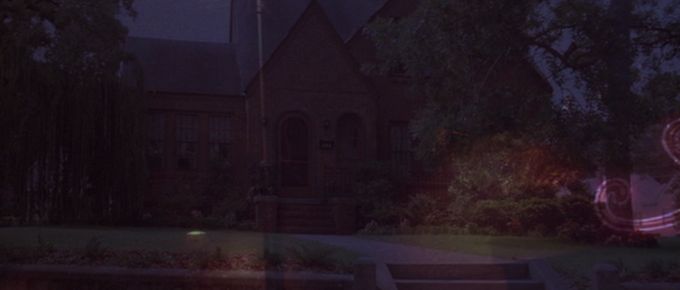 Back to selection
Back to selection
The Blue Velvet Project
Blue Velvet, 47 seconds at a time by Nicholas Rombes
The Blue Velvet Project, #35

Second #1645, 27:25
A slow dissolve, from Sandy’s house (she has just agreed to break her date with Mike and go to the Slow Club with Jeffrey) and the red neon sign of the Slow Club, in its elegant—but somehow slightly off-kilter–cursive. The dissolve, deriving from the pre-cinema technology of the magic lantern (there’s a nice example of a magic lantern dissolve about half-way down the webpage) to create transitions or to suggest time-lapsed effects, and isn’t there something magic in the very act of “dissolving” time? Two images: Sandy’s house, steady and unmoving, slowly overtaken by the Slow Club, which emerges as a slow crawl across the screen. The dark contours of Sandy’s house, like a ghostly presence, as the baroque, cursive letter S begins to accumulate in the far right of the frame.
In the midst of a dissolve, where are we? What temporal zone? The dissolve somehow manages to capture a moment of time that doesn’t really exist. We find ourselves somewhere uncharted between the just-past of Sandy’s house and the near-future of the Slow Club. The frame, fluttered with competing meanings: home, and leaving home. The dissolve is one of cinema’s early experiments with psychological (rather than linear) time, an attempt to capture the fragmented ways in which we experience time, not in linear fashion from point A to point B to point C, but rather from A to C. It’s there in Cinderella (1899) by George Méliès, an early example of a cinematic dissolve, at the 1:29, 2:34, and the 3:55-4:00 mark (the slowest dissolve).
Transported from one temporal and spatial location to another, the dissolve—unlike the cut—emphasizes the improbable, in-between moment, and in the Blue Velvet frame at second #1645 we witness something impossible: two overlapping realities appearing at the same time. Cinema’s own form of quantum entanglement.
Over the period of one full year — three days per week — The Blue Velvet Project will seize a frame every 47 seconds of David Lynch’s classic to explore. These posts will run until second 7,200 in August 2012. For a complete archive of the project, click here. And here is the introduction to the project.
